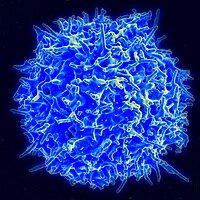
Photo from wikipedia
Secondary poor graft function (sPGF) is defined as secondary cytopenia after initial engraftment of allogeneic stem cell transplantation (allo-SCT). It has been shown to be associated with poor prognosis; however,… Click to show full abstract
Secondary poor graft function (sPGF) is defined as secondary cytopenia after initial engraftment of allogeneic stem cell transplantation (allo-SCT). It has been shown to be associated with poor prognosis; however, there are very few reports on the incidence, risk factors, and outcomes of sPGF. Between January 2015 and December 2015, 564 patients, who received transplantation at Peking University People’s Hospital, were retrospectively reviewed. Among the 490 patients who achieved initial engraftment of both neutrophils and platelets, 28 patients developed sPGF. The cumulative incidence of sPGF on day 100 was 5.7%. The median time of sPGF was 54.5 (34–91) days after transplantation. Low (< median) CD34+ cell dose (p = 0.019, HR 3.07 (95% CI, 1.207–7.813)), Epstein-Barr Virus (EBV) reactivation (p = 0.009, HR 3.648 (95%CI, 1.382–9.629)), and cytomegalovirus (CMV) reactivation (p = 0.003, HR 7.827 (95%CI, 2.002–30.602)) were identified as independent risk factors for sPGF. There was no significant difference in PGF incidence between the matched sibling donor (MSD) group and haploidentical donor (HID) group (p = 0.44). The overall survival of patients with sPGF at 1 year after transplantation was significantly poorer than that of patients with good graft function (GGF) (50.5% versus 87.2%, p < 0.001). In conclusion, sPGF developed in 5.7% patients after allo-SCT, especially in patients with CMV, EBV reactivation, or infusion with a low dose of CD34+ cells. The prognosis of sPGF is still poor owing to a lack of standard treatment.
Journal Title: Annals of Hematology
Year Published: 2019
Link to full text (if available)
Share on Social Media: Sign Up to like & get
recommendations!